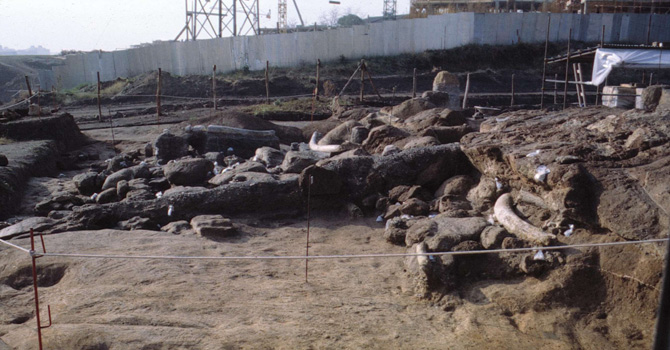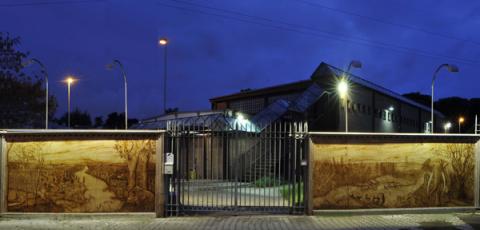The History
In 1981, during the urbanization of the district, the bucket of a digger penetrated into a Middle Pleistocene geological deposit, survived to the destroying actions of ancient and modern man.
The Archaeological Superintendence of Rome stopped the work and carried out an excavation that lasted five years (1981 to 1986) and involved an area of over 1200 mq. The prehistoric deposit included a stretch of the alveo of an ancient river, filled, over time, by gravels and sands, inside which, dragged and after deposited by river water, about 2,200 bones remains, more than 1,500 lithic finds and a fragment of an human skull were collected.

The value of the discovery urged on the Superintendence to plan the site's preservation.
Through a compromise between the need for preservation and the requirement of new roads, a change of City Plan was carried out. So the partial displacement of the expected road allowed the preservation of about 300 square meters of archaeological deposit.
At the same time an archaeological ban was issued to protect the area.
At the end of excavations, the site was preserved by a temporary cover, waiting for a real museum building. Due to the discontinuity of the required funding coming from various Bureaus and Offices, the current building has been realized in several stages.
Only in 1996, the Archaeological Superintendence, which was the State Office for the Protection of Archaeological Heritage, assigned to the Municipality of Rome (Superintendence to Cultural Heritage) the management of the area and the task of completing the musealization.
Through new funding, the construction of a large coverage building was completed in 2000. In the same year important restoration works were carried out, as the deposit had been subjected to vandalism acts and illegal occupation.
In 2007 an agreement with the V (now IV) Local Municipality and the Gardens Service of Rome, allowed to expand the outdoor area with the aim to realize a special garden, where to place the typical plants of the Middle Pleistocene, including some trees recognized in the site during excavation.
Other works of setting up have been carried out since 2006 and have allowed the fulfillment of the museum.
The Casal de 'Pazzi deposit is the last surviving one of a number of disappeared Pleistocene sites.
Since the mid-nineteenth century, this territory was actually characterized by large quarries for the extraction of building materials required for the expanding city yards. New roads and railways were also built. And old layers were thus revealed.
This was a positive requirement for geologists and paleontologists who collected abundant fossils from fluvial layers and volcanic strata produced by the intense activity of the Albano Volcano (now Alban Hills) during Pleistocene.
At the basis of the exposed stratigraphies the "Tufo litoide" was often visible. It was laid around 360,000 years ago and made up much of the famous Roman hills. Above, fluvial deposits of gravels, sands and clays were visible.
The finds were of different significance and relief, but constitute, as a whole, a territorial complex which, even today, has few comparisons. In order of discovery, the involved sites are: Ponte Mammolo, Monte delle Gioie, Sedia del Diavolo, Saccopastore, Ripa Mammea. None of these has survived, as all have been destroyed by the increase of the city.
The only still visible evidence is just the Casal de' Pazzi deposit.








































